 |

| |
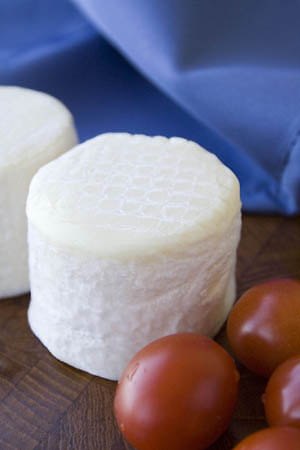
A snowy white crottin of chèvre. Although crottins are delicious, one explanation for the name is that, as it ages, it becomes dark and brownish like a horse dropping, the English translation of “crottin.” All photography by Claire Freierman. |
| WHAT IT IS: Award-winning artisan goat cheese, European-style cow’s milk cultured butters and other cow’s milk products. |
| WHY IT’S DIFFERENT: Outstanding quality from a pioneering artisan. All of the products—cheese, butter, crème fraîche, fromage blanc, mascarpone and quark—are award winners. |
| WHY WE LOVE IT: Who needs to go to France to eat the best goat cheese and butter, when you can have these delivered tomorrow? The mascarpone and quark are also favorites. |
| WHERE TO BUY IT: VTButterandCheeseCo.com. |
|
|
 |

Vermont Butter & Cheese:
Dairy Queen
CAPSULE REPORT: Today, you can buy a piece of decent chèvre in any major city—and hundreds of American goat cheeses are entered each year in the American Cheese Society’s annual competition. But in the early 1980s, few people knew what chèvre—goat cheese—was. Allison Hooper knew. She learned how to make it as an apprentice cheesemaker in Brittany, and returned to Vermont with a passion to make chèvre. Fortunately, she found a business partner and an audience of chefs—then consumers—eager to serve her products. Vermont Butter & Cheese Creamery became a leader in the American artisan cheese movement, and Americans learned how to love chèvre. (In honor of its 25th anniversary in 2009, the company changed its name from Vermont Butter & Cheese Company to Vermont Butter & Cheese Creamery.)
The goat cheeses were joined by European-style cow’s milk dairy products, also not well known, except to those who had dined well in Europe. Today, many American food enthusiasts have had the opportunity to try crème fraîche, mascarpone and even quark; fewer have had great artisan butters like VBC’s cultured, higher-butterfat contenders. These are the zenith of butters, as you’ll read in detail in the full review. And good news for the lactose intolerant: Any remaining lactose in the butter is consumed by the bacteria cultures used to create these special butters.
All of the cow’s milk products in this review are certified kosher by KOF-K, are carried by fine retailers nationwide and are available online. Join us in exploring these award-winning, artisan dairy products, and see their photos in the full review below.
|
| |
|
|
THE NIBBLE does not sell the foods we review
or receive fees from manufacturers for recommending them.
Our recommendations are based purely on our opinion, after tasting thousands of products each year, that they represent the best in their respective categories. |
Books For Turophiles (Cheese Lovers)
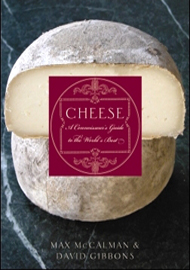 |
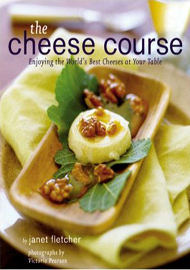 |
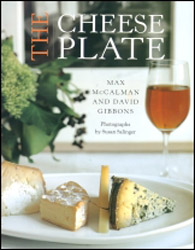 |
| Cheese: A Connoisseur’s Guide to The World’s Best, by Max McCalman. Maître Fromager McCalman profiles 200 of the world’s very best cheeses from A (Aarauer Bierdeckel) to Z (Zamorano). A wonderful book, complete with all the practical information and fascinating details a connoisseur could want. Click here for more information or to purchase. |
The Cheese Course, by Janet Fletcher. It’s more than four hunks of cheese on a wooden board: Learn how to prepare stunning and imaginative cheese courses that can be the highlight of an otherwise simple meal. The good news is that it’s relatively simple to do it—you don’t even have to know how to cook! This book is also a great gift for anyone who loves to entertain. Click here for more information or to purchase. |
The Cheese Plate, by Max McCalman. Dean of Curriculum and Maître Fromager at Artisanal Premium Cheese Center and School in New York City, McCalman has produced a wonderful book. It includes perhaps the best-published information about pairing cheese and wine. Click here for more information or to purchase. |
Vermont Butter & Cheese: Dairy Queen
INDEX OF REVIEW
|
MORE TO DISCOVER
|
Overview
With the ubiquity of chèvre in the U.S. today, it’s hard to think that, not too long ago, the only goat cheese around was imported from France. When Allison Hooper was a young woman with a degree in food science, Americans had to go to Europe to learn how to make artisan cheese. Even today, apprentices earn no money, just room and board; and if you want to learn to make French cheeses, you’d better speak French, because the farmer-cheesemakers in the countryside sure don’t speak English.
Allison returned to her native Vermont with a passion to make cheese, and a few years later had the opportunity to make chèvre for a banquet held by the Vermont Department of Agriculture. It was very well received, and in 1984, Allison and the Department of Agriculture’s marketing director, Bob Reese, decided to found Vermont Butter & Cheese Company—a pioneering decision, since artisan cheese wasn’t even a blip on the national radar.
Since then, the initial simple, mild, fresh goat’s milk cheese has expanded to a line of fresh, aged and flavored chèvres and a state-of-the-art cheesemaking facility. The lone cheesemaker now has a scientific approach to cheesemaking and a staff of 29 to assist. Almost all of its products have earned the most prestigious awards in cheesemaking.
Today, the company makes a line of gourmet cow’s milk dairy products in the European tradition: three types of cultured butter, crème Fraîche, mascarpone and quark. All of the cow’s milk products are made with pasteurized, rBGH-free milk and cream from 21 local family farms. The goat’s milk also comes from local farms, and VBC has a goat nanny—not a nanny goat, but an animal expert who works with the goat farmers to help ensure the happiest, most productive goats and best-quality milk for VBC’s goat cheeses.
The creamery uses microbial rennet so that the cheeses are vegetarian. (Rennet is a coagulating enzyme that is added to milk, as the first step in making cheese. It curdles the milk, causing curds to form and separate from the whey. Standard rennet is made from the lining of calves’ stomachs.) |
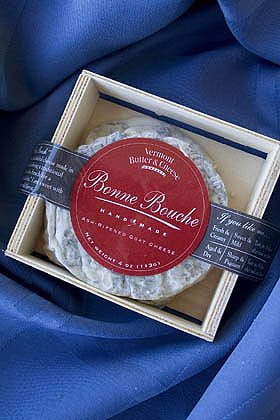
Bonne Bouche. One of our favorite nibbles at the 2007 Fancy Food Show, it won the top honors as best product in the Cheese and Dairy category. |
Fresh Chèvre
Chèvre, the French word for goat, is characterized by its snow-white paste and tangy, distinctive flavor. Fresh cheeses are most often sold as logs (bûches) and disks. With their creamy pastes, they are versatile partners...from the cheese board to fillings for crepes, omelets, chicken breasts and ravioli, to ingredients for cheesecake, even ice cream.
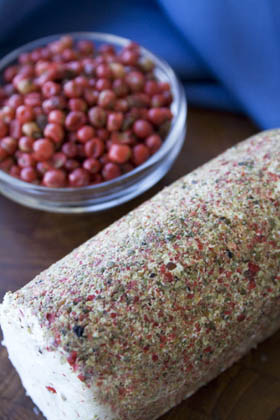
Delicious fresh chèvre with black, green and pink peppercorns has festive looks that turn any dish into party fare.
|
- One of our favorite light lunches is a “goatwich”: chèvre spread on a crusty roll, with a glass of Sauvignon Blanc. Sometimes the chèvre comes dressed, like the peppercorn chèvre at the left, or VBC’s basil chèvre. With the plain chèvre, we can serve it savory, with fresh tomatoes and basil and a few grinds of fresh pepper, or sweet, with a drizzle of our favorite Savannah Bee Company artisan honeys. (For fusion, try the honey with black pepper.)
- If you haven’t had a fresh chèvre pizza yet, you’re in for a treat. If you can score a cornmeal crust, so much the better.
- A classic mesclun salad adds a disk of goat cheese, or a slice from a log, often rolled in toasted pecans, pistachios or walnuts and baked or warmed. But if all you do is crumble it on salad, you’ll still be happy. It also pairs well with slices of pear or apple.
- Fresh chèvre on a good bagel is another favorite fusion food. It can make one forget cream cheese. Of course, add the smoked salmon and dill.
|
Aged Goat Cheeses: Bijou, Bonne Bouche, Coupole
As goat cheese ages, it develops an edible white rind. Aged chèvres are made in a variety of shapes, including cones, crottins, cylinders, disks, domes, logs and pyramids. The paste will vary from creamy to semi-firm, depending on the age.
VBC makes three aged chèvres, each distinctly different. In our comments, note that we obtained our cheeses directly from VBC. Cheeses purchased elsewhere may or may not have more age to them.
Bijou, shown at the top of the page, is a small crottin; the name means “jewel” in French. These little jewels are classically oven-warmed and served with a green salad. The thick paste is almost fudge-like, and perhaps even more enjoyable as it melts on the tongue. While one of these 1-1/2-inch diameter crottins would make a feast for a cheese lover, they can be halved and shared. One package contains two crottins.
- This cheese shows well at any course. If it is fresh or just mildly aged, enjoy it at a special breakfast with toast made from top-quality crusty bread.
Bonne Bouche (photo above), literally “good mouthful” and, more colloquially, “tasty morsel” in French, certainly is that and more. A hand-ladled (into molds), ash-ripened cheese with a bloomy rind, inside is a cheese far more delicate than Brie and many familiar cheeses of this category. You can play the affineur and age this charmer yourself at home. There’s a “made date” on the package, along with instructions on how to age it if you prefer the cheese softer and with a drier, more piquant rind. It has the mild, floral, acidic elements of a fresh chèvre, with the complex, nuttier notes of an aged cheese. We’re mad for it either way, and need to be restrained from eating the whole bouche at once.
|
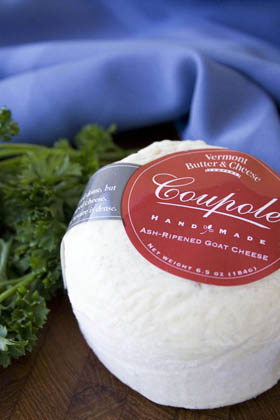
Coupole, the French word for dome, is a classic beauty that reads the script of goat cheese perfection. |
- Serve it quartered, with a mesclun salad dressed with a balsamic vinaigrette
- Serve it quartered in first course with grilled vegetables (asparagus, now in season,
are wonderful), drizzled with a little balsamic vinegar
Coupole (photo above) means dome, and this cheese is a lovely, snowy dome with classic flavors so dear to the hearts of lovers of chèvre. The recipe is the same as Bijou; the paste, a bit more dense. And, this shape remains standing no matter how many slices are taken from it. No toppled remains here—as if there will be any remains.
- This is a beautiful choice for a cheese board and a wonderful introduction to fine chèvre for those who have not experienced it.
- As a garnish, serve nuts (almonds, pecans, walnuts or a mix) and dried fruits or fresh pears.
- For an interesting salad course, top a mixture of radicchio and watercress, in a walnut oil vinaigrette, with a wedge of Coupole. Garnish with some fresh-cracked pepper.
Wine Pairings: All of these cheeses pair best with Sauvignon Blanc or Pinot Gris. If you must, try a lighter-style Chardonnay; but anything oaky will overpower the delicate flavors. Some people enjoy a dry, sparkling wine, but we have never felt that sparkling wine was the best pairing with these cheeses (on the other hand, for triple crèmes, bring on the bubbly). Those who only enjoy red wine should try a light-bodied Pinot Noir.
Cultured Butters
When you mention Vermont Butter & Cheese to people who have tasted the company’s butter, the first thing you hear is: “That butter is great!” How great can butter be, you ask? Well, how great can cheese be? VBC’s butter is so good, you’ll be tempted to eat it plain, just like a good piece of cheese. These world-class butters are made from that day’s fresh local cream. One bite and you’ll know you’re not in Kansas anymore, as Dorothy Gale might say...but you’ll know you’re in Vermont.
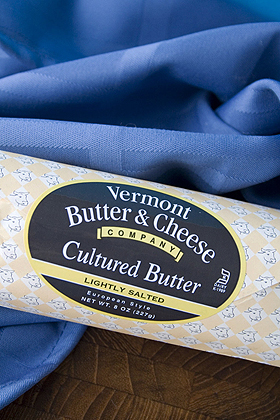
One of three types of cultured butter made by Vermont Butter & Cheese Company. After pasteurization, the cream is fermented by adding a bacteria culture. The cream rests in its vat for a day to allow the culture to develop complex flavors and aromas. This is the difference between cultured butter and regular, or sweet cream, butter. When fermentation is complete, the cream is churned into butter.
|
The company makes cultured butter, which is different from the sweet cream butter made in the U.S. Butter is made by churning fresh or fermented cream.
- Sweet cream butter, churned from fresh cream, is what most Americans eat. It is called sweet cream butter whether it is lightly salted, unsalted or whipped. The distinction is that it is made from sweet cream, not fermented or cultured cream (also called soured cream). Tidbit: Butter can be made from a combination of milk and cream, and must contain at least 80% milk fat (butterfat) by weight. Cheaper butters have more milk, artisan butters are all cream—and thus richer and more flavorful.
- Cultured butter is made from fresh cream; lactic acid cultures have been added for flavor development, which “ripens” the cream.* It is a richer style of butter, generally higher in butterfat and moisture, than sweet cream butter. This style is popular in Europe and is now being produced by artisans in the U.S. It is preferred by bakers, because butterfat levels as high as 86% create more elastic crusts and dough. (Read more in the caption at the left.) A good fresh, cultured butter has a delicate cream flavor—you can taste the fresh cream it was churned from—with faint nutty notes.
|
*Sweet cream butter first became available in the 19th century with the advent of refrigeration and other technology. Prior to then, cream was generally collected from several milkings over a few days, and natural fermentation had already begun by the time it was made into butter. During fermentation, bacteria convert milk sugars into lactic acid, which sours the cream and produces more complex flavors and aromas and a richer, more “buttery” product. In the U.S. and elsewhere, cultured butter is made from pasteurized cream with Lactococcus and Leuconostoc bacteria introduced to induce fermentation. However, in some countries, raw (unpasteurized) butter is available.
Not only are these butters exquisite in flavor; they are a boon to the lactose intolerant. During fermentation, the bacteria cultures consume almost all of the lactose that remains in regular butter to produce flavor. If you have a lactose-intolerant friend, we can’t imagine a better gift.
VBC makes three types of cultured butter: unsalted, lightly salted and sea salt.
The lovely yellow color—which does not show up in all of its glory in the photo at the right—comes from the high-quality diet of the cows. When cows are grazing on grass in a pasture, as opposed to eating feed in a barn, they ingest natural carotene in the grass. Carotene is the vegetable form of vitamin A found in carrots and all yellow and orange vegetables. In addition, artisan butter, churned in a “batch” or “barrel” churn, is more yellow than butter that is manufactured in a “continuous” churn.
Cultured Butters For Every Day
Warning: All three VBC butters are so good, if you have a habit of eating butter straight from the bar or tub, don’t try these alone. You’ll need friends to restrain you.
- The logs of unsalted or salted butter, shown wrapped above and partially-unwrapped at the right, are perfect for everyday cooking and eating.
- Both have won awards at the American Cheese Society’s annual competition.
|
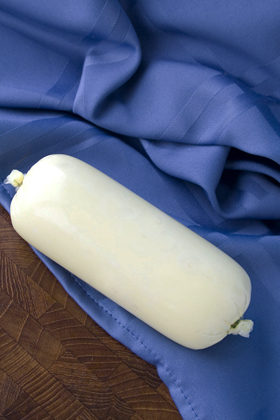 The cultured butter as it appears underneath the “happy cow” wrapping paper above (the butter is much more yellow in person). It’s easy to slice off what you need and re-wrap the rest for maximum freshness.
The cultured butter as it appears underneath the “happy cow” wrapping paper above (the butter is much more yellow in person). It’s easy to slice off what you need and re-wrap the rest for maximum freshness. |
We can’t tell you how good these are except to say, if you love butter, send for one of each. You’ll say, “Eureka!”†
†Eureka is Greek for “I have found it.” It is attributed to the Greek scholar and physician Archimedes, who reportedly shouted it upon discovering how to calculate the volume of irregular objects, until then an unsolvable problem. When stepping into his bath one day, he noticed the water level rise and realized that the volume of water that was displaced must be equal to the volume of the mass of his body. He is said to have been so excited by his discovery that he leaped out of the bath and ran through the streets of Syracuse naked (it wasn’t a misdemeanor back then). “Eureka” is also the state motto of California. It refers to the 1848 discovery of gold near Sutter’s Mill, which attracted people to the territory from all over the world, eventually creating the state.
The Unsalted Butter is a lovely butter that will enhance everything it touches. But we, who never eat regular salt butters, are so enamored of VBC’s two salted butters, we must twist your arm: If you’re not planning to buy all three, you must at least try the two salted varieties.
The Lightly Salted Butter is so wonderful: You taste the sweet cream on the palate before the tiniest amount of salt arrives to add more complexity. The butter has .33% salt—that’s one-third of a percent (known in French as demi-sel or half-salt), and one-sixth the salt of standard salted butter. The salt flavor is so light, this butter could “pass” as unsalted. But now that you know the salt is there, take a bite. Heaven! As salt does, it helps to enhance flavors, such that the Salted Butter tastes creamier and more buttery than the Unsalted Butter! Will all the butter manufacturers in America please try this and then reduce the amount of salt in their butters by 75%? VBC has converted us lifelong unsalted butter users away from the mother bar; we now use their Salted Butter as our daily spread. Yes, it’s that good.
- Aside from eating it with a spoon, which is what we cultists do, both butters are ideal for any type of cooking or baking.
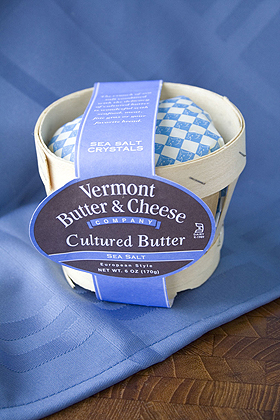 Cultured Butter With Sea Salt—the “Outstanding Cheese or Dairy Product” winner at the 2004 Fancy Food Show...and in our home. The small, handmade wooden basket holds the covered motte (French for pat—in this case, a six-ounce pat) of butter.
Cultured Butter With Sea Salt—the “Outstanding Cheese or Dairy Product” winner at the 2004 Fancy Food Show...and in our home. The small, handmade wooden basket holds the covered motte (French for pat—in this case, a six-ounce pat) of butter. |
Cultured Sea Salt Butter
But for special treats and favorite guests, we clamor for the Cultured Sea Salt Butter. It’s the same fine butter, salted with large crystals of Celtic sea salt. While Vermont Butter & Cheese Company began with a passion to make goat cheese, many view this Cultured Butter With Sea Salt, made from cow’s milk cream, as the company’s iconic product. Speak to cheesemongers and they’ll recommend several goat cheeses to you...and insist you take home a little wooden tub of this butter. Fine chefs serve it to their restaurant patrons...and no doubt nip at it from time to time, as we do.
We serve it for special occasions, because the aforementioned logs of Unsalted Butter and Lightly Salted Butter are plenty wonderful for every day, and, like a great wine, even if money is no object, you don’t want to get too familiar. You prefer that every bite will be as special when you have it again.
Can you see the salt crystals? If you look hard enough you can—but why look when you can taste? You’ll get the crunch and the fine French sea salt flavor in every exquisite bite.
|
Serving Suggestions
- Serve as a compound butter, adding a dab to grilled meats
- Garnish any vegetables—it’s worth the calories
- Use it as your butter with seafood or amazing corn on the cob
- Try it in cookie recipes (We tasted a memorable salted butter shortbread made with this butter, that made us want to try baking sea salt butter cookies. VBC also suggests using it in Crème Caramel.)
- The die-happy-and-smiling recipe: pan-toasted bread, sautéed with Cultured Butter With Sea Salt and topped with a slice of foie gras and a side of fresh figs
- Take it on a picnic—even to your patio. The bright French paper wrapping puts you back in the Old Country (France), even before the taste does
Crème Fraîche
Crème fraîche is cultured cream, a thickened cream with a slightly tangy, nutty flavor and velvety, creamy texture. The fresh cream is set aside to let the natural lactic bacteria take over. The bacteria thicken the cream to a consistency and richness almost like sour cream, though with a more delicate texture and tartness. It does not separate or curdle when cooked with wine or at high temperatures, so is perfect for thickening sauces and soups, and imparting rich flavor and texture—it is a staple of French cuisine. The French make crème fraîche with unpasteurized cream; in the U.S., all fresh diary products must be made with pasteurized milk or cream.
Serving Suggestions
Crème fraîche is the perfect accompaniment to everything, sweet or savory. It enhances everything from the caviar and blini at the beginning of the meal, to the chocolate cake at the end.
- With caviar and blini: the most sumptuous treat (crème fraîche smoothes out the saltiness of caviar)
- Easy hors d’oeuvre: dollop atop a piece of cocktail bread with a slice of smoked salmon
- With smoked salmon, capers and dill
- With fresh fruit and berries is a simple but delicious summer dessert
- Instead of whipped cream with shortcake (mix with a small amount of sugar)
- With fruit crisps and cobblers (add a sprinkle of cinnamon)
- On dark chocolate cake with sweetened Crème Fraîche and fresh raspberries
- With baked potatoes
- In sauces and soups (just a small amount of crème fraîche makes them extra creamy)
|
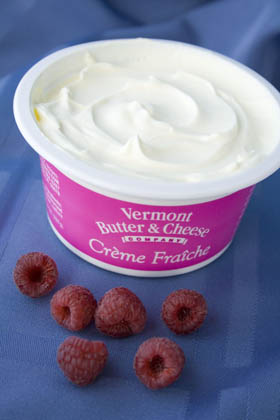
If you like sour cream, you’ll love crème fraîche. |
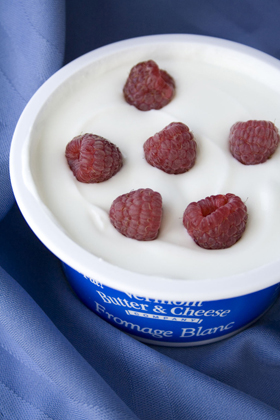
Fromage blanc, or “white cheese,” is snow white,
indeed. At 120 calories per cup—the same calories and
protein as fat-free triple-strained Greek yogurt—
you can eat the entire tub for lunch. |
Fromage Blanc
Fromage blanc is a cow’s milk cheese related to quark. It can be an astounding product: Whenever we are in France, we eat it nonstop (or at least twice a day, at lunch and from the cheese cart at dinner), rolling our eyes at how good it is. Some people sprinkle on a bit of sugar (try brown sugar!) or add fruit, but it requires nothing. It is totally fat free and all protein. (Quark is not fat free). Fromage blanc is also used in uncooked savory dishes. Since it has no butterfat, it will separate if cooked.
While fromage blanc looks like yogurt (see photo at left), it is a proper cheese, beginning with rennet and a starter culture added to the milk. However, the curds are not allowed to coagulate as they would with a traditional cheese. Instead, they are stirred to the consistency of yogurt.
We admit to preferring French varieties because of the greater richness in flavor achieved from the unpasteurized milk—you can’t believe you are eating something that is fat free. But they are not available in this country and we are not in France. Also, although the fromagier at a restaurant will tell you the product is fat free, some cheesemakers themselves tell you that they add cream to achieve more richness, which can produce a product with up to 8% fat. |
As for VBC’s Fromage Blanc versus yogurt: Try it. You may discover something new and wonderful. In comparing the two, we have to admit a preference for our favorite, triple-strained plain Greek yogurt, FAGE Total with 0% fat—in our eyes (and on our tongue), a miracle product. We’ll eat every tub of VBC’s Fromage Blanc that comes our way, but we’ll stick to the FAGE for a richer experience with the same protein and calories. (Regular yogurt has neither the same richness nor protein density.)
Mascarpone
We can thank the popular dessert, tiramisu, for making more mascarpone available in the U.S. It is called “Italian cream cheese,” but has nothing to do with what is used to make American cheesecakes, spread on bagel and used as a base for toppings of pepper jelly or preserves that is served as a spread with crackers. And mascarpone isn’t even cheese, as you’ll learn in a moment. What it is, is a thick spoonful of creamy, slightly sweet, ultra-rich complex-flavored dairy product that tastes like sweet cream married to sweet fresh cheese.
This cow’s milk product is native to the Lombardy region of Italy; however, it is not a cheese. In order to be a cheese, starter or rennet must be used in production. Mascarpone is made by draining the moisture from heavy cream using a small amount of citric acid and finely woven cloth. The result is similar to Devon cream or clotted cream.
Incorporated into recipes as an ingredient (tiramisu is one of the most famous), it also makes simple yet luscious desserts.
Serving Suggestions:
-
Serve with fresh fruit and biscuits, like ginger snaps and gourmet graham crackers
-
Top fresh berries and compotes
|
|
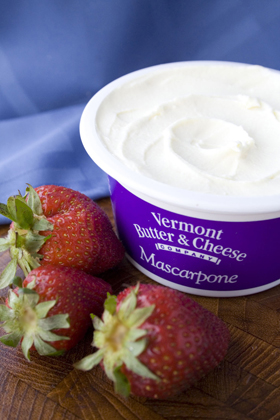
Thick, luscious mascarpone is often called “Italian
cream cheese,” but don’t even think of comparing it
to the product purchased in bricks or whipped in tubs. “Mascarpone” is one of the most misspelled words in the food world. People transpose the letters and erroneously call it mar-sca-pone. Nope. Think MASCAR, like NASCAR...but pronounce it mah-scar-POE-nay. |
- Stuff figs, dates or dried apricots (sprinkle with chopped pistachios)
- Use as the filling for cookie sandwiches
- Fill tart shells and top the mascarpone with fresh or dried fruit
- Enjoy on toast and muffins
- Toss with pasta and smoked salmon
Dessert Wine Pairing: Late Harvest Riesling, Passito di Pantelleria or Recioto di Soave.
Quark
Quark is the German word for curds.‡ This cow’s milk cheese, produced all over Central Europe, is virtually identical to Fromage Blanc, but is whipped before packaging and has a higher fat content—80 calories per two-ounce portion, 50 from fat, compared to Fromage Blanc’s 30 calories, zero from fat.
We love this quark. It has the flavor of a light sour cream, with the consistency of yogurt; and if you eat the whole tub as an indulgence, the 200 calories won’t kill you. Quark can be eaten like yogurt, blended with fruit or jam. It is also a common ingredient used in filled pastries, savory and sweet sauces, spreads, soufflés, cheesecakes and mousses. Quark is so popular in Germany that it accounts for almost half of that country's total cheese production (the average German eats about 10 pounds of quark a year).
‡Use of the word “quark” to describe elementary particles of matter was taken from a poem inserted by James Joyce into Finnegan’s Wake: “Three quarks for Muster Mark!/Sure he hasn’t got much of a bark/And sure any he has it’s all beside the mark.” This excerpt is from a 13-line poem directed against King Mark, the cuckolded husband in the Tristan and Isolde legend. Murray Gell-Mann, the physicist who received the 1969 Nobel Prize for his work in classifying quarks, was inspired by Joyce, not cheese curds. The allusion to three quarks seemed perfect to him, since originally there were only three subatomic particles.
|
|
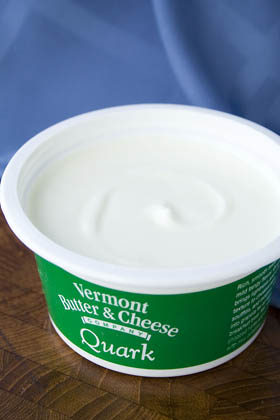
Quark has yogurt qualities in terms of viscosity and tang. But it’s made with rennet, so it’s technically a cheese. |
In addition to earning the American Cheese Society award, VBC’s Quark won a silver medal in the 2005 World Cheese Awards—quite an accolade, competing against all of those German quarks (the cheeses).
Serving Suggestions
- Sweeten with sugar, brown sugar, maple syrup or honey and/or serve with fresh fruit
- Blend with preserves and spread on a bagel (a lower-calorie, lower-fat alternative to strawberry or blueberry cream cheese)
- Mix with chopped herbs and serve on boiled new potatoes or as a spread on toast, sandwiches and wraps
- Substitute for sour cream (which, in comparison, has 120 calories, 100 from fat, per two-ounce portion)
Can you understand why we’re so happy with these products, and why we want to share them with everyone who loves fine food?
You can find wonderful recipes on VBC’s website for all of these delicious products—from potato salad with crème fraîche to the aforementioned foie gras toast. The company also makes creamy goat cheese spreads in tubs and a goat’s milk feta. We didn’t try them for this review, but we certainly look forward to the occasion.
FORWARD THIS NIBBLE to anyone who loves cheese, and especially to people who think they don’t like salted butter.
VERMONT BUTTER & CHEESE COMPANY
Artisan Cheese & Butter
Cow’s milk products are certified kosher by KOF-K
- Cultured Butter
Unsalted or Lightly Salted
8-Ounce Log
$4.50
With Celtic Sea Salt
6-Ounce “Motte”
$8.00
-
Fresh Chèvre
Herbs de Provence, Peppercorn or
Plain
4-Ounce Logs
$4.50
- Aged Chèvre
Bijou
2 Two-Ounce Crottins
$10.00
Bonne Bouche
4-Ounce Cheese
$9.00
Coupole
6.5-Ounce Cheese
$14.00
- Crème Fraîche, Fromage Blanc & Quark
8-Ounce Tub
$4.50
- Mascarpone
8-Ounce Tub
$4.50
- Gift Set
$50.00
Purchase online* at
VTButterAndCheeseCo.com
*Prices and product availability are verified at publication but are subject to change. THE NIBBLE does not sell products; these items are offered by a third party with whom we have no relationship. This link to purchase is provided as a reader convenience. |
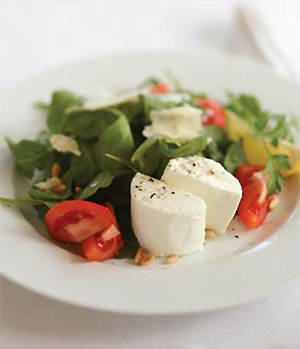
Salad made special with a crottin (Bijou).
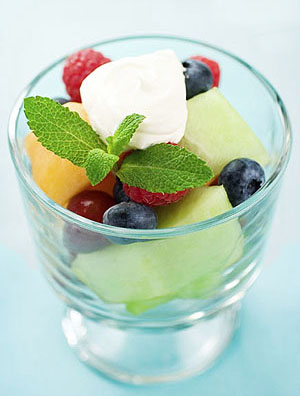
Fruit salad made festive with a dollop of crème fraîche or mascarpone.
|
Check Out These Sections Of
THE NIBBLE:

|
Check Out These Other “Top Pick Of The Week” Cheese & Butter:
|
FOR ADDITIONAL INFORMATION, special offers,
contests, opinion surveys, THE NIBBLE
back issues archive, product gift-finder and more,
visit the home page of TheNibble.com.
Do you have friends who would enjoy THE NIBBLE?
Click here to send them an invitation to sign up for their own copy. |
© Copyright 2004-2026 Lifestyle Direct, Inc. All rights
reserved. All information contained herein is subject to change at any time
without notice. All details must be directly confirmed with manufacturers, service
establishments and other third parties. This material may not
be reproduced, distributed, transmitted, cached, or otherwise used, except with
the prior written permission of Lifestyle Direct, Inc.
|
 |

|
 |




















